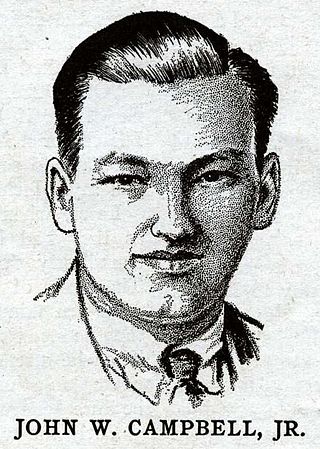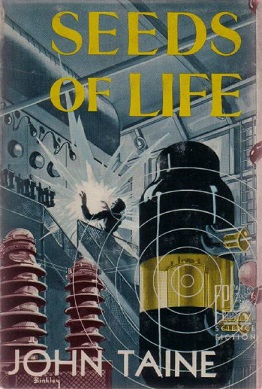
John Wood Campbell Jr. was an American science fiction writer and editor. He was editor of Astounding Science Fiction from late 1937 until his death and was part of the Golden Age of Science Fiction. Campbell wrote super-science space opera under his own name and stories under his primary pseudonym, Don A. Stuart. Campbell also used the pen names Karl Van Kampen and Arthur McCann. His novella Who Goes There? was adapted as the films The Thing from Another World (1951), The Thing (1982), and The Thing (2011).

This is a bibliography of works by American writer John W. Campbell Jr.

The Undesired Princess is a 51,000 word fantasy novella by American writer L. Sprague de Camp. It was first published in the fantasy magazine Unknown Worlds for February 1942. It was published in book form by Fantasy Publishing Company, Inc. in 1951. The book version also includes the 10,000 word fantasy short story "Mr. Arson", first published in Unknown for December 1941. The book was bound together with Stanley G. Weinbaum's The Dark Other in the omnibus collection Fantasy Twin by the same publisher in 1953. The title story was also published in paperback by Baen Books in 1990 together with David Drake's story The Enchanted Bunny, under the combined title The Undesired Princess & the Enchanted Bunny.

The Legion of Space is a science fiction novel by the American writer Jack Williamson. It was originally serialized in Astounding Stories in 1934, then published in book form by Fantasy Press in 1947 in an edition of 2,970 copies. A magazine-sized reprint was issued by Galaxy in 1950, with a standard paperback following from Pyramid Books in 1967. The first British edition was published by Sphere Books in 1977. The Legion of Space has been translated into German, French, Italian and Japanese . It has also appeared in the omnibus Three from the Legion, which compiles the novel and all but one of its sequels.

Invaders from the Infinite is a science fiction novel by American writer John W. Campbell Jr. It was simultaneously published in 1961 by Gnome Press in an edition of 4,000 copies and by Fantasy Press in an edition of 100 copies. The book was originally intended to be published by Fantasy Press, but was handed over to Gnome Press when Fantasy Press folded. Lloyd Eshbach, of Fantasy Press, who was responsible for the printing of both editions, printed the extra copies for his longtime customers. The Fantasy Press edition was issued without a dust-jacket. Eshbach eventually did produce a jacket in 1990 at the urging of George Zebrowski. The novel is an expansion of stories that originally appeared in the magazine Amazing Stories Quarterly.

Triplanetary is a science fiction novel and space opera by American writer E. E. Smith. It was first serialized in the magazine Amazing Stories in 1934. After the original four novels of the Lensman series were published, Smith expanded and reworked Triplanetary into the first of two prequels for the series. The fix-up novel Triplanetary was published in book form in 1948 by Fantasy Press. The second prequel, First Lensman, was a new original novel published in 1950 by Fantasy Press.

The Incredible Planet is a science fiction fix-up novel by American author John W. Campbell, Jr. It was published in 1949 by Fantasy Press in an edition of 3,998 copies. The novel is a collection of three linked novelettes that were not accepted for the magazine Astounding SF. The stories are sequels to Campbell's 1934 novel The Mightiest Machine.

The Bridge of Light is a science fiction novel by American writer A. Hyatt Verrill. It was originally published in the Fall 1929 edition of the pulp magazine Amazing Stories Quarterly. It was subsequently republished in book form in 1950 by Fantasy Press in an edition of 2,556 copies.

The Moon Is Hell! is a collection of two stories, one science fiction, the other sword and sorcery, by American writer John W. Campbell Jr. It was published in 1951 by Fantasy Press in an edition of 4,206 copies. The title story, published for the first time in this collection, deals with a team of scientists stranded on the Moon when their spacecraft crashes, and how they use their combined skills and knowledge to survive until rescue, including building shelter from meteor showers, and creating their own oxygen from Lunar rock. The second story, "The Elder Gods", Campbell rewrote, on a short deadline, from a story by Arthur J. Burks purchased for Unknown but later deemed unsatisfactory. It originally appeared in the October 1939 issue of Unknown under the pseudonym Don A. Stuart. The title of the eponymous story is occasionally found without the exclamation point, but the punctuation is used for the title of most editions of the collection itself.

Seeds of Life is a science fiction novel by American writer John Taine. It was first published in 1951 by Fantasy Press in an edition of 2,991 copies. The novel originally appeared in the magazine Amazing Stories Quarterly in October 1931.

The Crystal Horde is a science fiction novel by American writer John Taine. It was first published in book form in 1952 by Fantasy Press in an edition of 2,328 copies. The novel is substantially rewritten from a version that originally appeared in the magazine Amazing Stories Quarterly in 1930 under the title White Lily.

The Black Star Passes is a fixup of science fiction short stories by American author John W. Campbell Jr. It was first published in 1953 by Fantasy Press in an edition of 2,951 copies. The book is the first in Campbell's Arcot, Morey and Wade series, and is followed by the novels Islands of Space and Invaders from the Infinite. The stories originally appeared in the magazines Amazing Stories and Amazing Stories Quarterly, and were "extensively edited" for book publication, with Campbell's approval, by Lloyd Arthur Eshbach.

The Heads of Cerberus is a science fiction novel by American writer Francis Stevens. The novel was originally serialized in the pulp magazine The Thrill Book in 1919, and it was first published in book form in 1952 by Polaris Press in an edition of 1,563 copies. It was the first book published by Polaris Press. A scholarly reprint edition was issued by Arno Press in 1978, and a mass market paperback by Carroll & Graf in 1984.

The Abyss of Wonders is a science fiction novel by American writer Perley Poore Sheehan. It was first published in book form in 1953 by Polaris Press in an edition of 990 copies. It was the second and final book published by Polaris Press and included an introduction by P. Schuyler Miller. The novel originally appeared in the magazine Argosy in 1915.

The Time Stream is a science fiction novel by American writer John Taine. The novel was originally serialized in four parts in the magazine Wonder Stories beginning in December 1931. It was first published in book form in 1946 by The Buffalo Book Company in an edition of 2,000 copies of which only 500 were ever bound. It is the first novel to see time as a flowing stream.

The Mightiest Machine is a science fiction novel by American writer John W. Campbell, Jr. The novel was originally serialized in 5 parts in Astounding Stories magazine from December 1934 to April 1935, and was published in book form in 1947 by The Hadley Publishing Co. in an edition of 1,200 copies. Campbell was a leading figure in the Golden Age of Science Fiction.
Shasta Publishers was a science fiction and fantasy small press specialty publishing house founded in 1947 by Erle Melvin Korshak, T. E. Dikty, and Mark Reinsberg, who were all science fiction fans from the Chicago area. The name of the press was suggested by Reinsberg in remembrance of a summer job that he and Korshak had held at Mount Shasta.

Drome is a fantasy novel written and illustrated by John Martin Leahy. Originally serialized in the magazine Weird Tales in five parts beginning January 1927, it was first published in book form in 1952 by Fantasy Publishing Company, Inc. in an edition of 1,000 copies.

The Incomplete Enchanter is a collection of two fantasy novellas by American writers L. Sprague de Camp and Fletcher Pratt, the first volume in their Harold Shea series. The pieces were originally published in the magazine Unknown in the issues for May and August 1940. The collection was first published in hardcover by Henry Holt and Company in 1941 and in paperback by Pyramid Books in 1960.

"...and some were human." is the first story collection by science fiction writer Lester del Rey, originally published in hardcover by Prime Press in 1948 in an edition of 3,050 copies if which 50 were specially bound, slipcased and signed by the author. The stories first appeared in Astounding and Unknown. An abridged paperback edition, including only eight of the twelve stories, was issued by Ballantine Books in 1961. A Spanish translation, reportedly dropping only one story, appeared in 1957.




















